Florence flooding spreads as storm heads northeast
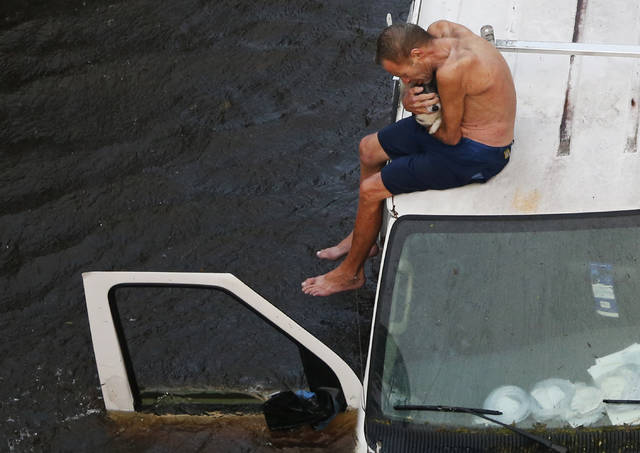
Willie Schubert of Pollocksville, N.C., cradle his dog Lucky as he waits to be rescued by a U.S. Coast Guard helicopter crew off a stranded van in Pollocksville, Monday, Sept. 17, 2018, in the aftermath of Hurricane Florence. (AP Photo/Steve Helber)
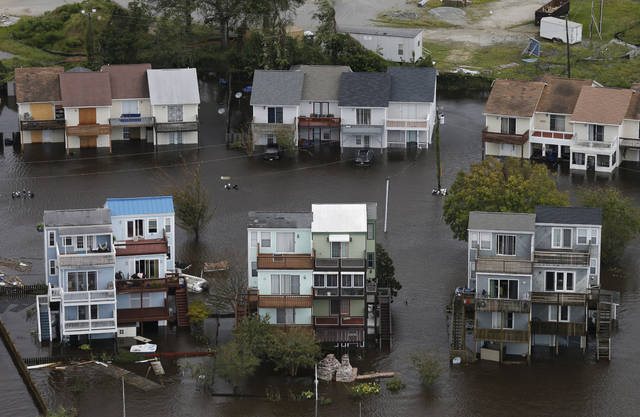
Homes along the New River are flooded as a result of high tides and rain from hurricane Florence which moved through the area in Jacksonville, N.C., Sunday, Sept. 16, 2018. (AP Photo/Steve Helber)
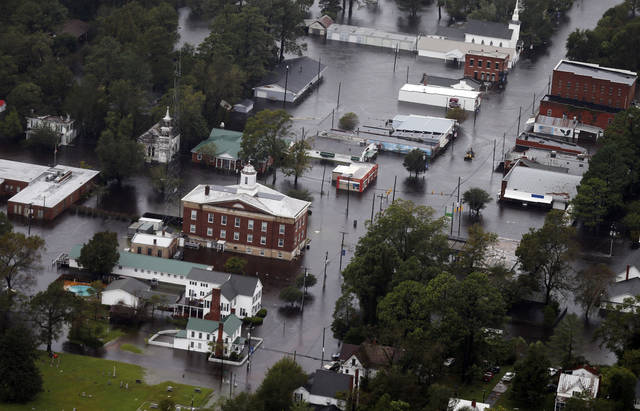
Floodwaters from Hurricane Florence inundate the town of Trenton, N.C., Sunday, Sept. 16, 2018. (AP Photo/Steve Helber)
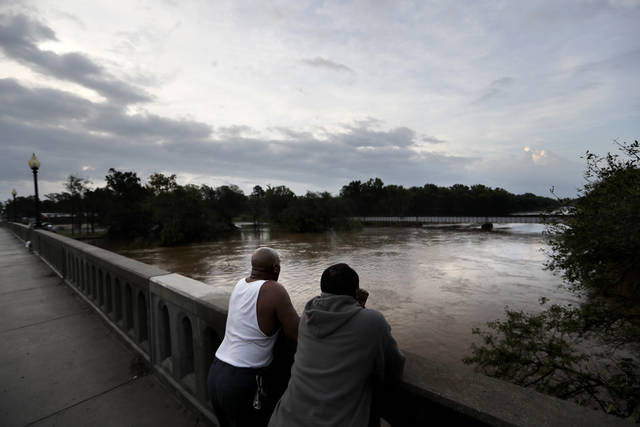
Gerald Generette, right, and Maurice Miller look onto the Cape Fear River as it continues to rise in the aftermath of Florence in Fayetteville, N.C., Monday, Sept. 17, 2018. (AP Photo/David Goldman)
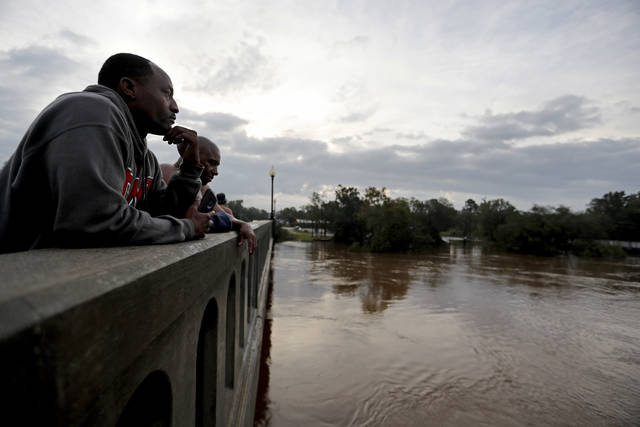
Gerald Generette, left, and Maurice Miller look onto the Cape Fear River as it continues to rise in the aftermath of Florence in Fayetteville, N.C., Monday, Sept. 17, 2018. (AP Photo/David Goldman)
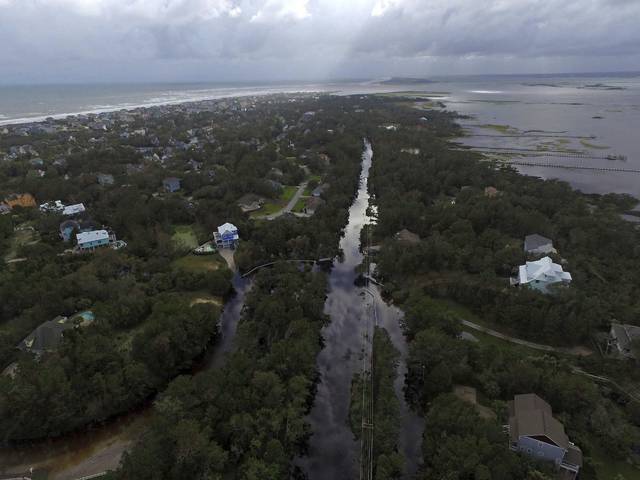
Coast Guard Road leading to the south end of Emerald Isle is seen after Hurricane Florence hit Emerald Isle, N.C., Sunday, Sept. 16, 2018. (AP Photo/Tom Copeland)
WILMINGTON, N.C. — Emergency workers delivered truckloads of food and water to Wilmington, a city of 120,000 people cut off from the rest of North Carolina by Florence’s still-rising floodwaters, as rescuers elsewhere used helicopters and boats to pull inland residents from homes swamped by swollen rivers.
WILMINGTON, N.C. — Emergency workers delivered truckloads of food and water to Wilmington, a city of 120,000 people cut off from the rest of North Carolina by Florence’s still-rising floodwaters, as rescuers elsewhere used helicopters and boats to pull inland residents from homes swamped by swollen rivers.
The deadly storm was still dumping rain and had top winds around 30 mph (50 kph) early Monday, but forecasters said it was expected to gradually pick up forward speed and complete a big turn toward the Northeast, which also is in for a drenching of as much as 6 inches (15 centimeters) of rain.
Flooding worries were increasing in West Virginia and Virginia, where roads were closed and power outages were on the rise. About 500,000 homes and businesses were in the dark.
The spreading disaster claimed additional lives Monday, with at least 18 people confirmed dead, and the nation’s top emergency official said other states were in the path this week.
“Not only are you going to see more impact across North Carolina … but we’re also anticipating you are about to see a lot of damage going through West Virginia, all the way up to Ohio as the system exits out,” Brock Long of the Federal Emergency Management Agency said Sunday on Fox News.
North Carolina emergency response officials tweeted that 23 truckloads of military meals and bottled water were delivered overnight to Wilmington , the state’s eighth-largest city.
Residents there waited for hours outside stores and restaurants for water and other basic necessities. Police guarded the door of one store, and only 10 people were allowed inside at a time.
Desperate for gas to run a generator at home, Nick Monroe waited in a half-mile-long (.8 kilometer-long) line at a Speedway station even though the pumps were wrapped in plastic. His power went on Thursday before Florence hit the coast, but he couldn’t recall exactly when.
“It’s all kind of a blur,” said Monroe, the sky overhead sunny and bright after the rain finally stopped.
County commission chairman Woody White said officials were planning for food and water to be flown into the coastal city, located on a peninsula with the rising Cape Fear River to the west and more water to the east.
To the north in Pollocksville, Coast Guard members used a basket suspended from a helicopter to rescue a man from the roof of a flooded home.
About 70 miles (115 kilometers) away from the coast, residents near the Lumber River stepped from their homes directly into boats floating in their front yards; river forecasts showed the scene could be repeated in towns as far as 250 miles inland as waters rise for days.
In Anson County, east of Charlotte, a train derailed on Sunday evening, but it wasn’t clear whether it was storm-related or if anyone was injured. Several cars of a CSX train left the tracks, WBTV reported.
The derailment led to at least one road closure. Officials have reported flooding caused by Tropical Storm Florence in Union County, located between Charlotte and Anson County.
Florence was still massive, despite being downgraded to a tropical depression from a once-fearsome Category 4 hurricane. Radar showed parts of the sprawling storm over six states, with North and South Carolina in the bull’s-eye.
Meanwhile, halfway around the world, Typhoon Mangkhut barreled into southern China on Sunday after lashing the Philippines with strong winds and heavy rain that left dozens dead. More than 2.4 million people were evacuated from China’s southern Guangdong province ahead of the massive typhoon, the strongest to hit the region in nearly two decades.
In North Carolina, fears of what could be the worst flooding in the state’s history led officials to order tens of thousands to evacuate, though it wasn’t clear how many had fled or even could.
President Donald Trump said federal emergency workers, first responders and law enforcement officials were “working really hard.” As the storm “begins to finally recede, they will kick into an even higher gear.”
“Very Professional!” he declared in a tweet.
The storm’s death toll climbed to 18 as authorities found the body of a 1-year-old boy who was swept away by floodwaters in North Carolina after his mother drove into floodwaters and lost her grip on him while trying to get back to dry land.
The problem was water, and lots of it, in Wilmington.
Victor Merlos was overjoyed to find a store open for business in Wilmington since he had about 20 relatives staying at his apartment, which still had power. He spent more than $500 on cereal, eggs, soft drinks and other necessities, plus beer.
“I have everything I need for my whole family,” said Merlos. Nearby, a Waffle House restaurant limited breakfast customers to one biscuit and one drink, all takeout, with the price of $2 per item.
Julie Lamb, with her 15-month-old twins, stepped off a Coast Guard boat after being rescued from her parents’ house, where the yard was submerged and water was still rising at Lumberton. Another boat was going back to get her husband, 4-year-old daughter and their pug dog.
“We decided to stay with mom and dad here. During Matthew the water never reached their house,” she said. “But the water keeps coming up in their yard.”
As rivers swelled, state regulators and environmental groups were monitoring the threat from gigantic hog and poultry farms located in low-lying, flood-prone areas.
The industrial-scale farms contain vast pits of animal feces and urine that can pose a significant pollution threat if they are breached or inundated by floodwaters. In past hurricanes, flooding at dozens of farms also left hundreds of thousands of dead hogs, chickens and other decomposing livestock bobbing in floodwaters.
Some stream gauges used to monitor river levels failed when they became submerged, but others showed water levels rising steadily, with forecasts calling for rivers to crest at or near record levels. The Defense Department said about 13,500 military personnel were assigned to help relief efforts.
Authorities ordered the immediate evacuation of up to 7,500 people living within a mile (1.6 kilometers) of a stretch of the Cape Fear River and the Little River, about 100 miles (160 kilometers) from the North Carolina coast. The evacuation zone included part of the city of Fayetteville, population 200,000.
Near the flooded-out town of New Bern , where about 455 people had to be rescued from the swirling flood waters, water completely surrounded churches, businesses and homes. In the neighboring town of Trenton, downtown streets were turned to creeks full of brown water.
The rain was unrelenting in Cheraw, a town of about 6,000 people in northeastern South Carolina. Streets were flooded and Police Chief Keith Thomas warned people not to drive, but the local food and gas store had customers.
“As you can tell, they’re not listening to me,” he said.
———
Associated Press writers Alex Derosier in Fayetteville, North Carolina; Jonathan Drew in Lumberton, North Carolina; Allen G. Breed and Emery P. Dalesio in New Bern, North Carolina; Denise Lavoie and Sarah Rankin in Richmond, Virginia; Gary Robertson and Martha Waggoner in Raleigh, North Carolina; Meg Kinnard and Jeffrey Collins in Columbia, South Carolina; Russ Bynum in Cheraw, South Carolina; Seth Borenstein and Michael Biesecker in Washington; Lolita C. Baldor at the Pentagon; Jennifer Kay in Miami; and Jay Reeves in Atlanta contributed to this report.
———
For the latest on Hurricane Florence, visit https://www.apnews.com/tag/Hurricanes

